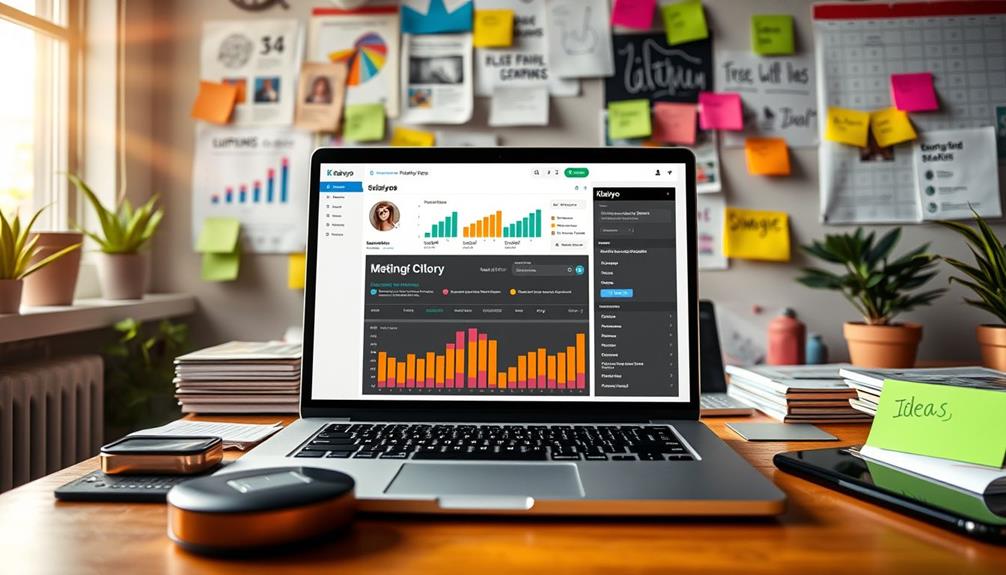Email marketing tools are platforms that help you grow your subscriber list, automate campaigns, and track performance. They connect with your CRM, social media, and e-commerce channels to streamline your efforts. These tools enable you to personalize messages, segment audiences, and optimize send times for better engagement. Choosing the right platform depends on your goals and scale. Keep exploring to discover how these tools can take your email marketing to the next level.
Key Takeaways
- Email marketing platforms offer tools for list building, automation, and personalization to enhance campaign effectiveness.
- They integrate with CRM, social media, and e-commerce systems for seamless data management.
- Popular platforms include Mailchimp, Constant Contact, and HubSpot, each with unique features and target use cases.
- Features like analytics dashboards and A/B testing help optimize email campaigns based on engagement metrics.
- Selecting the right software depends on your goals, scale, and focus on list growth, automation, or detailed analytics.

Have you ever wondered how businesses effectively reach their audiences in today’s digital world? It all comes down to smart email marketing tools that help you craft targeted campaigns, build your list, and measure success through engagement metrics. When you’re starting out, list building is your foundation. You want to grow a high-quality email list filled with subscribers genuinely interested in what you offer. The right platform makes this process seamless by providing opt-in forms, landing pages, and integrations that encourage visitors to sign up. As your list expands, maintaining its quality becomes essential, and good email marketing tools allow you to segment your list based on interests, behaviors, or demographics. This segmentation helps you send more personalized content, which boosts overall engagement.
Once you’ve grown your list, the focus shifts to nurturing your subscribers. Engagement metrics are your best indicators to gauge how well your emails resonate. Open rates tell you how many people are interested enough to open your message, while click-through rates show who’s engaging further by clicking links. Bounce rates and unsubscribe rates reveal whether your emails are hitting the mark or if you need to refine your approach. The best email marketing platforms provide detailed analytics dashboards, giving you real-time insights into these metrics. This data allows you to tweak your campaigns, test different subject lines, content formats, or send times, ensuring you optimize your efforts continually.
A good platform also streamlines automation, enabling you to send targeted follow-ups based on subscriber actions. For example, if someone downloads a resource or abandons a shopping cart, automated sequences can nurture these leads without manual effort. This automation not only saves time but also personalizes the experience, making your subscribers feel valued and understood. Additionally, integrations with other tools — like CRM systems, social media platforms, or e-commerce solutions — amplify your marketing power. You can sync data, automate workflows, and create cohesive campaigns that reach your audience wherever they are. Utilizing features like audience segmentation can further enhance your campaign effectiveness by targeting specific groups with tailored messages.
Choosing the right email marketing software depends on your goals and scale. Some platforms excel at list building and automation, while others focus more on analytics and engagement tracking. Whichever you pick, focus on how well it helps you grow your list, foster meaningful interactions, and analyze engagement metrics to refine your strategies. Ultimately, the most effective email marketing tools empower you to deliver relevant content consistently, turning subscribers into loyal customers and advocates for your brand.
Frequently Asked Questions
How Do I Choose the Right Email Marketing Tool for My Business?
To select the right email marketing tool, consider how well it supports your audience segmentation and personalization strategies. Look for platforms that allow you to target specific groups and customize content easily. Confirm it integrates with your existing systems and offers automation features. Test different options, read reviews, and prioritize user-friendly interfaces. This way, you’ll find a tool that boosts engagement and helps you achieve your marketing goals effectively.
What Are the Main Differences Between Free and Paid Email Marketing Platforms?
Free platforms flaunt fundamental features but face fierce feature limitations and flexible pricing models. Paid platforms provide powerful tools, premium support, and personalized options, promising more professional results. You’ll find the difference in the depth of data, design, and delivery options. While free tools tempt with cost, paid platforms push performance, ensuring your email campaigns captivate your audience, convert customers, and create lasting connections with all-encompassing capabilities.
How Secure Are Email Marketing Platforms in Protecting Customer Data?
You can trust email marketing platforms to safeguard customer data, especially when they use data encryption and strong user authentication. These security measures ensure that your customers’ information stays confidential and safe from unauthorized access. While no system is completely foolproof, choosing reputable platforms with robust security features helps mitigate risks. Regular updates and compliance with data protection laws further enhance data security, giving you peace of mind when managing customer information.
Can These Tools Integrate With My Existing CRM or E-Commerce Systems?
Think of your email marketing tool as a puzzle piece that fits seamlessly into your business landscape. It easily integrates with your CRM, creating a unified heartbeat of customer data, and syncs with your e-commerce system to track sales and behavior. This smooth compatibility guarantees you can target, personalize, and grow your audience without missing a beat, transforming your marketing efforts into a harmonious symphony.
What Are the Best Practices for Avoiding Spam Filters With Email Campaigns?
To avoid spam filters, focus on subject line optimization and maintaining your sender reputation. Craft clear, relevant subject lines that avoid spammy words, and personalize your messages. Regularly clean your email list to remove inactive subscribers, which boosts your sender reputation. Avoid overusing capital letters or excessive punctuation, and always include a clear unsubscribe link. These steps help guarantee your campaigns land in inboxes rather than spam folders.
Conclusion
Now that you’ve explored these email marketing tools, think of them as your trusted compass guiding your messages through the bustling digital landscape. With the right platform, your campaigns can soar like a well-trained flock, reaching the right audience at just the right moment. Embrace these tools, and watch your email efforts bloom into a vibrant garden of connections and conversions, turning every send into a memorable handshake in the vast world of inboxes.








